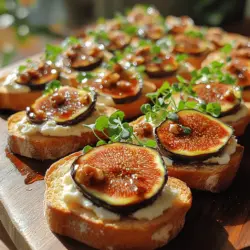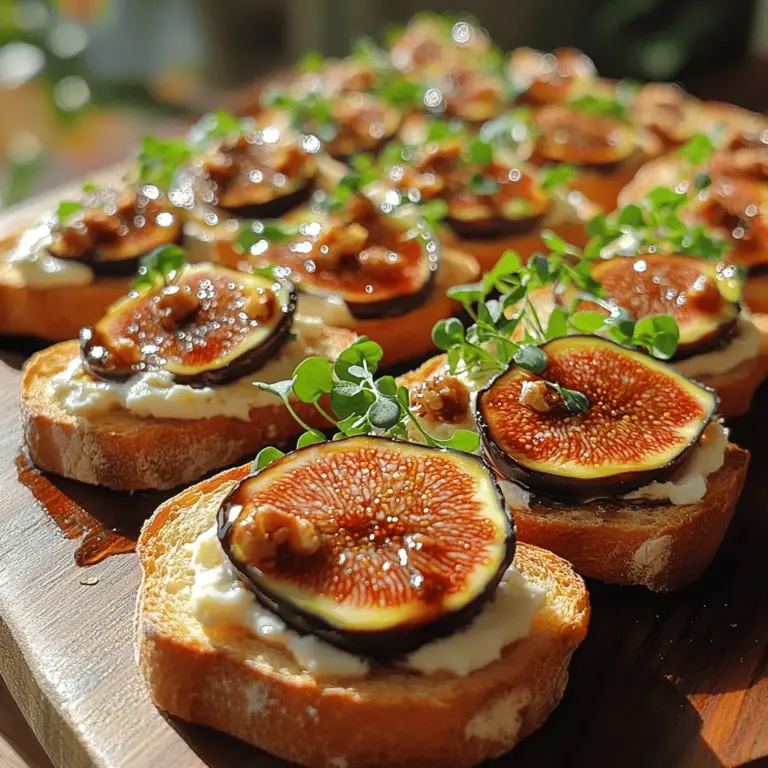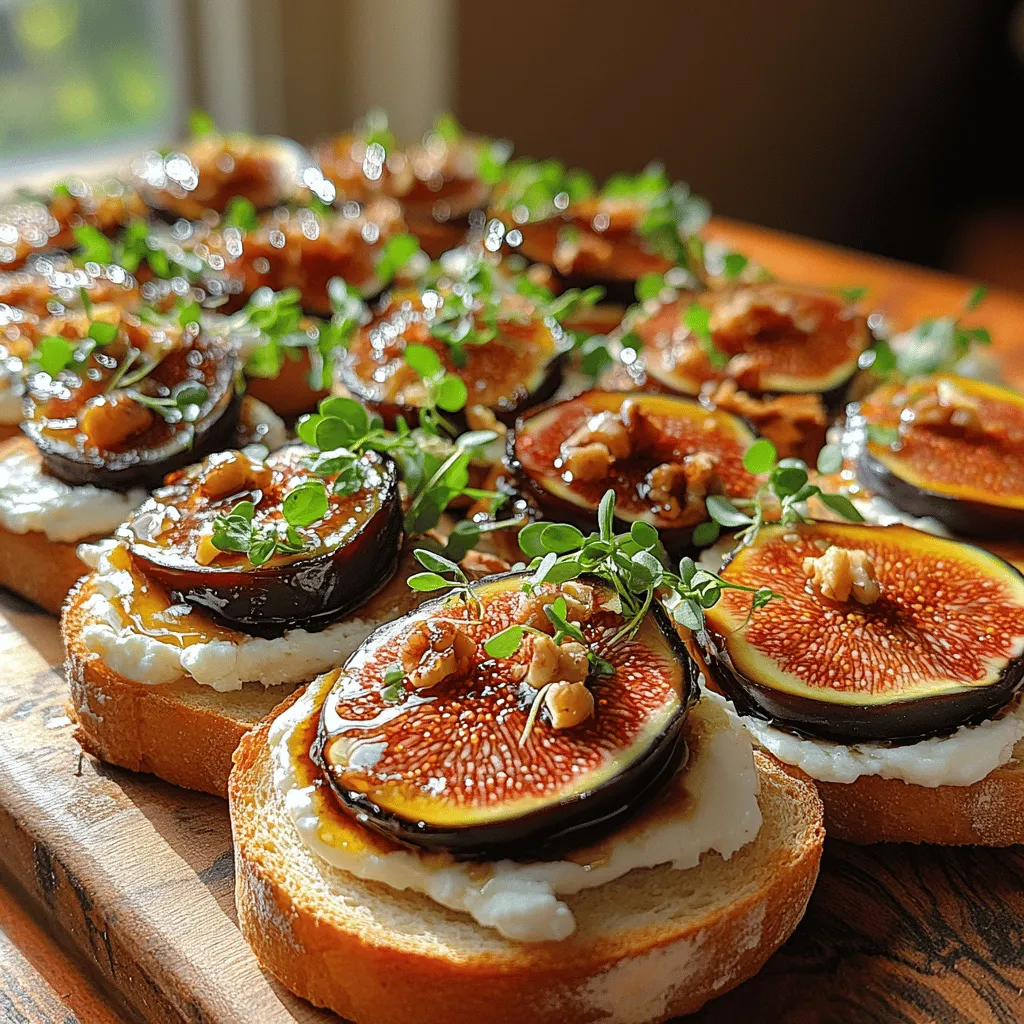Introduction
Balsamic roasted fig crostinis are a delightful appetizer that elegantly marries the sweet, rich flavor of fresh figs with the tangy depth of balsamic vinegar and the creamy texture of goat cheese. This dish is perfect for any occasion, from festive gatherings to intimate dinners, and it’s sure to impress guests with its vibrant presentation and sophisticated taste. In this article, we will guide you through the steps of creating these gourmet crostinis, exploring the nuances of each ingredient and offering insights into the culinary techniques that will elevate this simple recipe to a memorable experience.
The allure of balsamic roasted fig crostinis lies not only in their flavor but also in their versatility. Figs, with their unique sweetness, pair beautifully with a variety of savory and sweet elements. This makes the crostini a favorite among home cooks and professional chefs alike. Furthermore, the seasonal nature of figs enhances the overall flavor profile, allowing you to create a dish that feels fresh and relevant throughout the year.
The Appeal of Balsamic Roasted Fig Crostinis
Understanding the Popularity of Fig-Based Appetizers
Figs have been celebrated for centuries for their luxurious taste and health benefits. As a fruit that is both sweet and savory, figs lend themselves beautifully to a range of culinary applications. The combination of figs with balsamic vinegar creates a harmonious balance of flavors; the acidity of the vinegar cuts through the sweetness of the figs, resulting in a dish that is complex and satisfying. This balance is precisely what makes fig-based appetizers, like our balsamic roasted fig crostinis, so popular among food enthusiasts.
The Versatility of Crostinis in Entertaining
Crostinis are a staple in the world of appetizers, and for good reason. Their versatility allows for endless combinations of toppings, making them suitable for any palate or occasion. The base of toasted baguette provides a satisfying crunch that complements the toppings beautifully, and the small size of crostinis makes them perfect for mingling at parties or as a starter to a multi-course meal. Whether you’re hosting a summer barbecue, a holiday party, or a romantic dinner for two, crostinis can be tailored to fit the theme, season, and ingredients you have on hand.
How Seasonal Ingredients Enhance Flavor Profiles
One of the key elements to creating memorable dishes is the use of seasonal ingredients. When you choose fresh, in-season figs, you’re not only supporting local farmers but also ensuring that the fruit is at its peak in terms of flavor and nutritional value. Seasonal ingredients often offer a depth of flavor that out-of-season counterparts cannot match. For instance, pairing freshly roasted figs with the rich sweetness of honey and the sharp tang of balsamic vinegar creates a dynamic flavor profile that is reflective of the season. This attention to seasonal sourcing enhances the overall dining experience, making each bite an ode to the bounty of nature.
Ingredient Breakdown
Fresh Figs: The Star of the Dish
Figs are often regarded as the star ingredient in this recipe, and for good reason. These small fruits are not only delicious but also packed with nutritional benefits. Rich in vitamins, minerals, and antioxidants, figs are known for their high fiber content, which can aid digestion and promote heart health. When selecting figs for roasting, it’s crucial to choose fresh, ripe figs that yield slightly when pressed. Look for figs that are plump and have a deep color; avoid any that are overly soft or have blemishes.
Balsamic Vinegar: The Flavor Enhancer
Balsamic vinegar is a key player in the flavor profile of balsamic roasted fig crostinis. Unlike traditional vinegar, balsamic vinegar is made from freshly crushed grape juice that is aged and reduced, resulting in a rich, sweet flavor. This unique profile complements the natural sweetness of the figs, enhancing their flavor without overpowering them. When using balsamic vinegar in this recipe, opt for a high-quality aged variety for the best results. The complexity of flavors that a good balsamic vinegar brings to the dish will elevate the overall taste experience.
Honey: Natural Sweetness
While figs provide a natural sweetness, adding honey to the mix brings an additional layer of flavor that balances the dish beautifully. Honey not only enhances the sweetness but also adds a floral note that complements the figs and balsamic vinegar. It’s important to choose a good-quality honey, as the flavor can vary significantly depending on the source. For those with dietary restrictions, alternatives such as agave syrup or maple syrup can be used to achieve a similar sweetness without compromising on taste.
Olive Oil: A Culinary Staple
Quality olive oil is crucial in this recipe for drizzling over the crostinis before baking. Extra virgin olive oil, in particular, offers a robust flavor that enhances the overall dish. The richness of the oil contributes to the mouthfeel of the crostinis while also helping to caramelize the figs during roasting. When selecting olive oil, look for varieties that are cold-pressed and have a rich, fruity flavor. This will ensure that the oil not only adds moisture but also enhances the taste of the entire dish.
Goat Cheese vs. Ricotta: A Creamy Choice
Choosing the right cheese is essential for achieving the desired creaminess and flavor in your crostinis. Goat cheese offers a tangy, creamy texture that pairs exceptionally well with the sweetness of figs and the acidity of balsamic vinegar. Alternatively, ricotta cheese can be used for a milder flavor and a lighter texture. If you have dietary preferences or restrictions, consider using vegan cream cheeses as an alternative. The choice between goat cheese and ricotta ultimately depends on your personal taste and the desired flavor profile of the dish.
Baguette: The Perfect Base
The base of our crostinis is a crispy baguette that provides the necessary crunch to offset the creamy toppings. When selecting a baguette, look for one that is fresh and has a nice crust. A traditional French baguette works wonderfully, but you can also experiment with whole grain or sourdough varieties for a twist on the classic. To achieve the perfect crunch, slice the baguette into thin pieces and toast them in the oven until golden brown. This step is crucial, as it ensures that the crostinis hold up well under the toppings without becoming soggy.
Garnishes: Adding the Finishing Touch
To elevate your balsamic roasted fig crostinis visually and flavor-wise, consider garnishing them with fresh arugula or microgreens. These greens not only add a pop of color but also introduce a peppery freshness that balances the richness of the cheese and figs. When choosing garnishes, opt for fresh, high-quality greens that will enhance the overall presentation of your dish. A sprinkle of freshly cracked black pepper can also add an extra layer of flavor that ties the components together beautifully.
With this detailed breakdown of ingredients, you are now equipped to begin your journey in creating balsamic roasted fig crostinis. Each component plays a vital role in crafting a dish that is not only delicious but also visually appealing. In the next section, we will dive into the step-by-step instructions to prepare this gourmet appetizer, ensuring that you can replicate this delightful recipe in your own kitchen. Stay tuned for tips and techniques that will help you create crostinis that impress at any gathering.
The Crunch Factor: Walnuts vs. Pistachios
When preparing your Balsamic Roasted Fig Crostinis, the choice of nut can significantly influence the overall taste and texture of the dish. While walnuts present a classic pairing with figs due to their earthy flavor and crunch, pistachios offer a unique twist with their vibrant color and slightly sweeter profile. Both nuts provide a satisfying crunch that complements the softness of roasted figs.
If you prefer a more traditional approach, opt for walnuts, which will harmonize beautifully with the balsamic glaze and creamy cheese. On the other hand, if you’re feeling adventurous, pistachios can add a delightful pop of color and flavor, giving your crostinis an upscale touch. Ultimately, the choice between walnuts and pistachios comes down to personal preference, but both will enhance the overall experience of this appetizer.
Step-by-Step Preparation
Prepping the Figs for Roasting
To achieve the best flavor infusion, start by selecting ripe, fresh figs. Aim for figs that are plump and slightly soft to the touch, with a rich, dark color. Begin by washing and drying the figs thoroughly. Once clean, slice each fig in half lengthwise.
In a medium bowl, toss the halved figs with a drizzle of high-quality balsamic vinegar, a sprinkle of brown sugar, and a pinch of salt. This mixture not only enhances the natural sweetness of the figs but also ensures an even coating, allowing the flavors to meld beautifully during roasting. Stir gently to coat the figs evenly, being careful not to mash them. An even coating is crucial as it allows the balsamic reduction to caramelize uniformly, creating a delicious glaze that will elevate your crostinis.
Roasting Process: Achieving the Perfect Caramelization
With your figs prepared, preheat your oven to 375°F (190°C). Arrange the coated figs on a parchment-lined baking sheet, cut side up, ensuring they are spaced apart to allow for even heat circulation. Roast the figs in the preheated oven for about 15 to 20 minutes.
Monitoring the figs is essential; you’ll want to check for doneness when they begin to caramelize at the edges and their natural juices start bubbling. The goal is to achieve a golden-brown exterior while maintaining the soft, juicy interior. If you have a kitchen thermometer, you can check that the internal temperature reaches approximately 190°F (88°C) for optimal texture.
Toasting the Baguette: Finding the Right Balance
While the figs roast, it’s time to prepare the baguette for your crostinis. For the best results, slice a fresh baguette into ½-inch thick slices. You can toast the baguette in one of two ways: either in the oven or on the stovetop.
For oven-toasting, preheat your oven to 400°F (200°C). Arrange the baguette slices on a baking sheet and brush one side with olive oil. Bake for about 5 to 7 minutes, flipping halfway through, until they are golden brown and crispy.
Alternatively, for stovetop toasting, heat a skillet over medium heat. Add the baguette slices and toast them for about 2-3 minutes on each side until they achieve a beautiful golden crust. This method allows for more control, and you can monitor the color closely to prevent burning. Regardless of the method you choose, aim for a balance between a crispy exterior and a slightly chewy interior for the perfect crostini base.
Assembling the Crostinis: A Visual Guide
Now that your figs are roasted and baguette slices are toasted, it’s time to assemble your crostinis. Start with the toasted baguette slices as your base. Spread a generous layer of creamy goat cheese or ricotta on each slice. The creaminess of the cheese will balance the sweetness of the figs and the tanginess of the balsamic glaze.
Next, place a roasted fig half on top of the cheese, cut side up. Drizzle a little of the balsamic reduction over the figs for an extra burst of flavor. To finish, sprinkle your choice of chopped walnuts or pistachios on top, adding a delightful crunch. For presentation, consider garnishing with fresh herbs like thyme or mint to add a pop of color and freshness to the dish.
Serving Suggestions
Creating an Elegant Presentation
Presentation is key when it comes to impressing your guests with your Balsamic Roasted Fig Crostinis. Arrange the assembled crostinis on a beautiful serving platter, making sure to space them evenly for an inviting look. Consider using a wooden board or a slate platter to give your dish a rustic feel.
To further elevate your presentation, you can create height by stacking some crostinis or arranging them in a circular pattern. Drizzle additional balsamic glaze artistically over the platter or around the crostinis for visual appeal.
Pair your crostinis with complementary beverages to enhance the dining experience. A crisp white wine, such as a Sauvignon Blanc or a light-bodied red like Pinot Noir, can bring out the flavors of the figs and balsamic. For non-alcoholic options, consider offering sparkling water infused with lemon or herbal iced teas.
Variations to Explore
While the classic balsamic roasted fig crostinis are undeniably delicious, there are countless variations to explore based on seasonal ingredients or personal tastes. For a seasonal twist, consider incorporating other fruits such as roasted peaches or pears, which pair well with the sweetness of the figs and the creaminess of the cheese.
You can also experiment with savory additions. A sprinkle of fresh rosemary or thyme can add an aromatic touch, while a dash of crushed red pepper flakes can introduce a hint of heat. Additionally, using flavored goat cheese, such as honey-infused or herbed varieties, can add a unique layer of flavor to your crostinis.
Nutritional Information
Understanding the nutritional profile of your Balsamic Roasted Fig Crostinis can help you enjoy them guilt-free. Each serving (typically 2-3 crostinis) contains approximately 200-250 calories, depending on the amount of cheese and nuts used.
Figs are a great source of dietary fiber, which aids in digestion, and they are rich in antioxidants and vitamins, making them a nutritious choice. Walnuts and pistachios provide healthy fats and protein, contributing to heart health. If you are mindful of dietary restrictions, this recipe is easily adaptable—vegan cheese can replace traditional cheese, and gluten-free baguettes can be used for those with gluten sensitivities.
Conclusion
Balsamic roasted fig crostinis are not just an appetizer; they represent the beauty of simple ingredients working harmoniously together. With their rich flavors and pleasing presentation, these crostinis are sure to impress your guests or provide a delightful treat for yourself. By understanding each component and following the preparation steps, anyone can recreate this sophisticated dish at home, making it a staple for future gatherings.
Whether you are hosting a casual get-together or a formal dinner party, these crostinis will undoubtedly steal the show. With the right balance of flavors, textures, and attention to detail, your Balsamic Roasted Fig Crostinis will become a beloved recipe that you will turn to time and again. Happy cooking!


